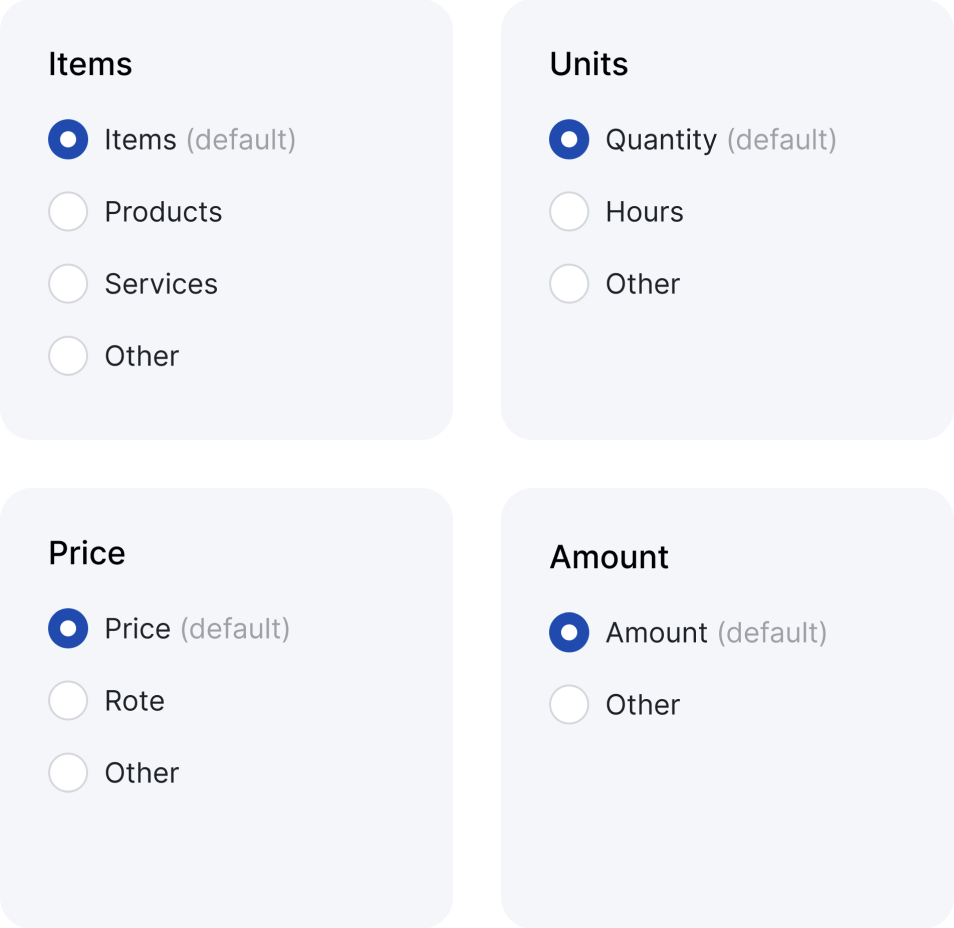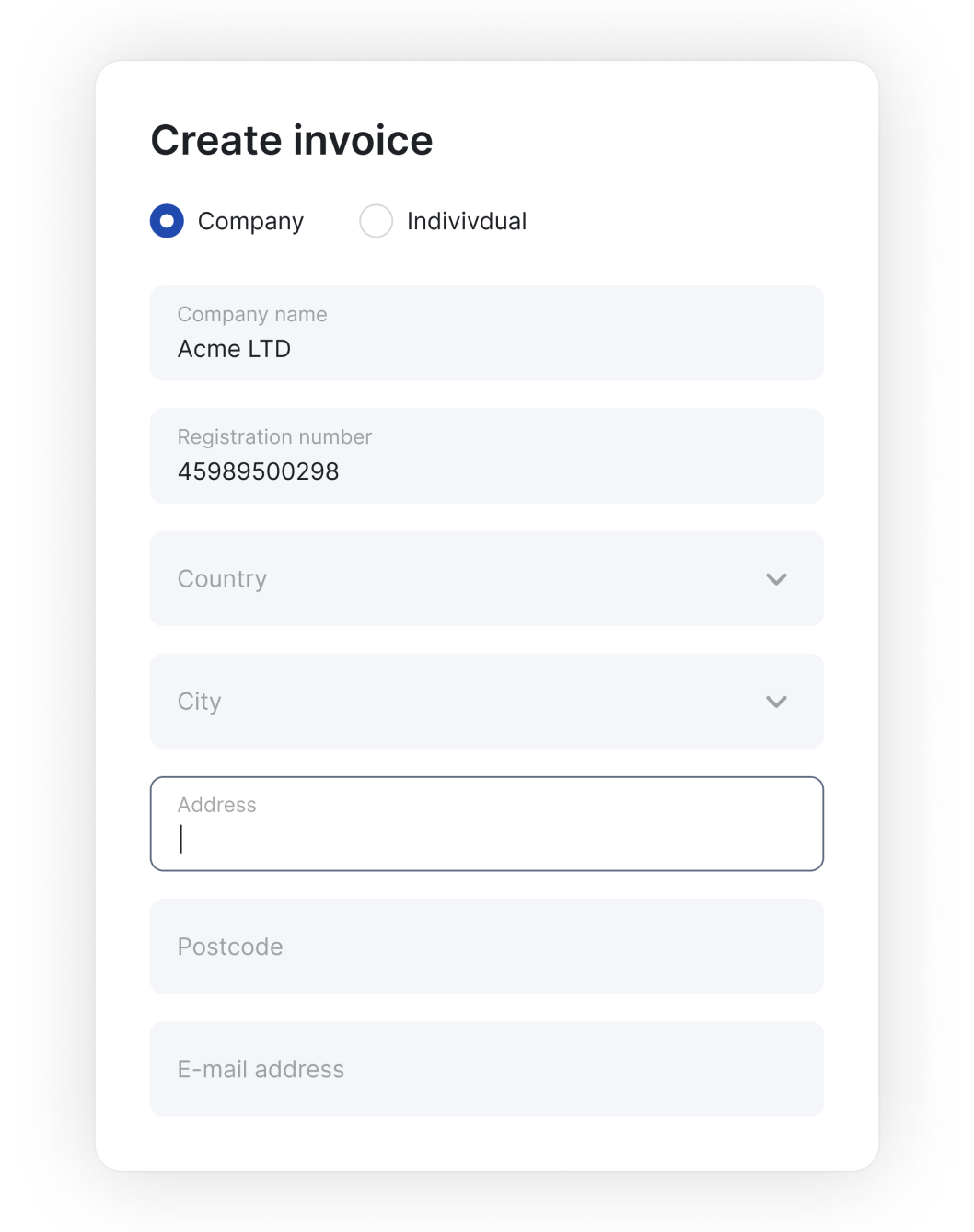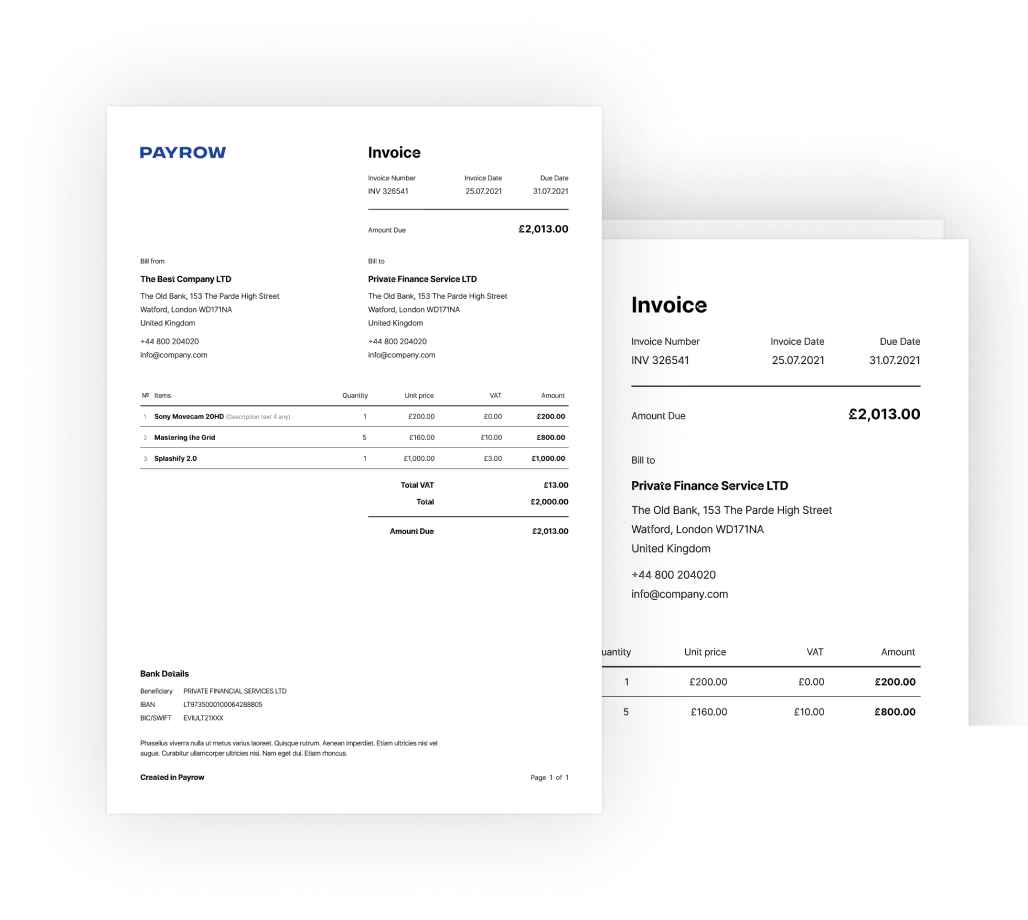Online Invoices for Your Business
Control outgoing and incoming payments with free invoicing software for Payrow clients. Simplify your business process and have fewer admin days.
Customise the Invoices
With Payrow invoicing software, you can edit your invoices information: titles and other columns

Choose Your Pricing Plan
Micro business
£19/mIdeal at the start of your journey
Get started for freeSmall business
£29/mYou're growing and we're here to help
Get started for freeBusiness plus
£99/mMore included as standard to fuel your ambition
Get started for freeCustom
from£299/mA truly unique account
Get started for free
FAQ
What is an online invoice?
An invoice is a document that confirms that goods have been shipped to the customer or services have been rendered and indicates the value of the products. The seller issues an invoice to their customers, requesting payment for the goods or services provided. This document is presented to the buyer either before or after the transaction and creates an obligation for the buyer to pay. Read more in our blog.
Are online invoices legally binding?
Yes, online invoices serve as a legally binding agreement between the seller and the buyer and cannot be cancelled or removed from sales records from an accounting perspective. If your company is registered as a VAT (value-added tax) payer, it is compulsory for invoices to be drawn up following the HMRC VAT invoices rules.
What should be included in an online invoice?
You must follow specific requirements when invoicing and taking payment from a customer. Let’s look through these elements:
- A unique identification number – you must assign an invoice number to each invoice to comply with the regulatory requirements. These requirements include a reference number, which is especially useful when discussing payments and sales invoices with accountants.
- Your company’s details – specify your business name, address, and contact information. If you have a limited company or LLP, you should give your registration number and address as Companies House requires. If you are self-employed, you should give your first and last name and the business name under which you operate, if applicable.
- Your customer’s details – specify the company name, contact information, and address of the customer you’re invoicing. In certain situations, it may be beneficial to identify other individuals, such as your contact with the organisation or the person who led your project.
- A clear description of what you’re charging for – state what items were sold and charged for. Include the name of the product or service, quantity (or time for services) and rate (per item or hour).
- The dates – include the date the goods or service were provided (supply date) and the date the invoice was raised.
- The amount being charged – specify the amount(s) that a buyer will pay you (mention all the charges, if there were several) and the total amount owed. If you ship physical products, include the costs you paid for that.
- VAT amount – include the value-added tax, if applicable.
- Payment terms – provide various payment options to your customers, including monthly instalments or discounts (it’s up to you). Include the specific due date for payment according to your requirements and preferences, ranging from immediate payment upon receipt of the invoice to up to 30 days.
What are the advantages of using online invoices over paper invoices?
Invoice automation benefits include the following:
- Improved Accuracy and Reduced Errors. When invoices are processed automatically, there is no room for human error or typos during data entry. Invoice data is captured automatically and checked for accuracy before being entered into the system, saving time and ensuring data is error-free.
- Time and Cost Savings. An invoice automation system helps businesses save money by reducing their reliance on paper invoices and eliminating the need to hire employees to perform manual data entry.
- Accessing all your bills in one convenient location reduces time spent searching for specific documents and improves productivity.
- Quicker Invoicing Cycles. Using invoice processing automation software, the bills are loaded into the system mechanically and checked for accuracy, allowing firms to accept payments considerably faster than they could if they relied on manual data entry.
- Real-Time Visibility into Financials. The invoice automation process offers more oversight and real-time data regarding accounts payable by consolidating all invoices into a single location. Having a rapid snapshot of all your pending payments at any given time gives you an excellent command over when invoices are due and improves your ability to budget for the future.
- Better Vendor-Customer Relationship Management. Invoice process automation makes maintaining positive relationships with suppliers and customers easy. In an automated system, retrieving data takes only a few seconds. The timely payment of vendors is ensured via alerts and notifications sent to relevant parties.
How do I create an online invoice?
An invoice is an itemised list showing the goods or services you have provided to your customers, the total amount payable, and how they can pay you for these goods or services. You can easily send an invoice via Payrow.
To send an invoice to your client:
- Click on the “Invoices” tab in the main menu of your Payrow Business account.
- Click the “New Invoice” button at the top of the screen.
- Add or select the customer you need.
- Select the appropriate currency.
- Add the product(s) the invoice relates to and click “Continue”.
What online invoicing software do you recommend?
The advantages of using automation software can’t be emphasised enough because it provides a practical way to improve productivity. However, with so many alternatives, it is difficult to select the one that is most suited for your company.
There are some things to keep in mind when searching for the best invoice automation software.
Scalability for Future Growth
By choosing a software solution that provides the ability to scale for future growth, you can be sure that it will be able to keep up with the expansion of your company.
Integration Flexibility
The versatility of the software will shield your business from future issues as your firm expands, saving hassle as growth accelerates.
Data Security and Compliance
When evaluating invoice management software, data security should always come first. Any software that handles sensitive financial data must be compliant with security policies and guidelines.
Cost-Effectiveness and ROI Analysis
The expenses associated with manually processing invoices (postage, paper, etc.) are reduced with invoice automation software. In addition to saving money, invoice processing automation software should boost your company’s return on investment. When compared to the cost of manually processing an invoice, which averages around 14 GBP, the cost of automating accounts payable is as much as three times lower.
How much does it cost to open a Payrow business account?
Account opening is free of charge. We also offer a free trial month (£0 monthly fee) for all new customers for the first month with Payrow.
Our tariff plans start from £19/month, and you can change your plan at any moment. Payrow has no transaction limits for all tariff plans.
For other plans and their benefits, please check our pricing page.
How do I send online invoices to my customers?
An invoice is an itemised list showing the goods or services you have provided to your customers, the total amount payable, and how they can pay you for these goods or services. You can easily send an invoice via Payrow.
To send an invoice to your client:
- Click on the “Invoices” tab in the main menu of your Payrow Business account.
- Click the “New Invoice” button at the top of the screen.
- Add or select the customer you need.
- Select the appropriate currency.
- Add the product(s) the invoice relates to and click “Continue”.
In which currencies can I issue invoices?
You can send invoices in the following currencies: GBP, EUR. More questions are here.
How can I provide my customers with invoices?
An invoice is an itemised list that records the products or services you provided to your customers, the total amount due, and a method for them to pay you for those items or services. You can easily send an invoice through the Payrow account.
To send an invoice to your customer:
- Click on the 'Invoices' tab on the main menu in your Payrow Business account
- Click “New Invoice” button on the top of the screen
- Add or select the customer you plan to send money to
- Choose the relevant currency, add the item(s) the billing relates to and click 'continue'
Read more about Payrow Invoices here.

